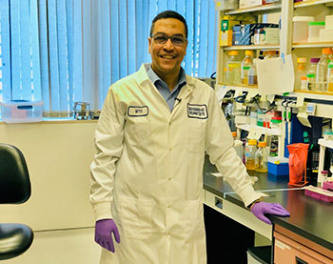For more information
Media Relations
Agriculture and Agri-Food Canada
1-866-345-7972
aafc.mediarelations-relationsmedias.aac@agr.gc.ca
Canada’s food processing sector has one of the highest standards in the world for producing quality and safely processed foods, such as meat products. Strict sanitation protocols ensure food safety from the producer to the consumer. Yet, along that chain, bacteria and viruses may pose a risk to human safety, despite best efforts to mitigate their presence.
There are both helpful and harmful types of bacteria that exist in natural environments. Outbreaks of foodborne illness can result if foods contaminated with harmful (pathogenic) bacteria reach the marketplace, subsequently triggering recalls and investigations by health and regulatory authorities. Examples of bacteria that can be harmful to human health include Shiga-toxin producing Escherichia coli (STEC), Salmonella and Listeria monocytogenes. In addition to the impact of recalls on public health and the integrity of the food supply, foodborne illness outbreaks can adversely impact a company’s brand, reputation, as well as have financial implications.
Bacterial Biofilms — What are they?
Biofilms are communities of living cells that may form on, and stick to, a wide variety of surfaces including areas where food is processed. These biofilms are found in many places (for example, equipment, drains, walls) and may contribute to allowing bacteria to resist conventional disinfection processes. Biofilms allow bacteria to persist for long periods of time in processing environments, leading to the potential contamination of food products.
That’s why Agriculture and Agri-Food Canada (AAFC) researchers examined the behaviours of these bacteria in meat processing environments. A multidisciplinary research team from across Canada simulated and analyzed various types of bacterial biofilms to address this problem.
Meet the Team
The collaborative research team included:
- Kentville Research and Development Centre – Dr. Timothy Ells, Dale Hebb, and Michele Elliot.
- Saint-Hyacinthe Research and Development Centre – Dr. Louise Deschênes, Dr. Tony Savard, Dr. Julie Brassard, Dr. Évelyne Guévremont, Nancy Guertin, François St-Germain, Marie-Josée Gagné, and Caroline Lapointe.
- Guelph Research and Development Centre – Dr. Hany Anany, Dr. Sampathkumar Balamurugan, Laura Arvaj, and Janet Lin.
- Lacombe Research and Development Centre – Dr. Devin Holman, Dr. Xianqin Yang, Madhu Badoni, Frances Tran, Dr. Hui Wang, Dr. Jeyachchandran Visvalingam, Dr. Yuan Fang, Dr. Peipei Zhang, Zhaohui Xu, Scott Hrycauk, Annie He, Rebecca Lohmann, Danielle St. Jean, Katherine James-Gzyl, and TingTing Liu.
What the Team Discovered
The science team simulated real environments where STEC, Salmonella and Listeria bacteria proliferate, studying them in the presence of other bacterial strains and additional stresses typically found in meat processing areas.
“Our team has discovered unique characteristics of bacterial biofilms that provide insights into how pathogenic bacteria can behave in a processing environment. These findings can help inform use of appropriate materials with anti-fouling properties in processing environments and improve sanitation protocols across the processing supply chain.”
- Dr. Sampathkumar Balamurugan, Research Scientist, Agriculture and Agri-Food Canada
A number of important discoveries have emerged from this work to strengthen the team’s understanding of the behaviours of pathogenic bacteria in food processing facilities. These findings can lead to improved strategies and best practices to minimize the presence of pathogenic biofilms:
- In a biofilm, pathogenic bacteria compete for space and, in doing so, may enter into mutually-beneficial or competitive relationships with other good and bad bacteria, sometimes integrating into existing biofilms present on meat processing surfaces.
- In a multi-bacterial environment, some bacteria (for example, Pseudomonas) may contribute to the survival and proliferation of pathogens, even in the presence of sanitizing chemicals, whereas other bacteria may inhibit the growth of pathogenic bacteria.
- Surface roughness cannot be used to predict the degree to which Listeria can attach to a specific grade of stainless steel.
- Other living cells (microorganisms) can act as effective deterrents against Listeria, STEC, or Salmonella.
- Reducing chemical use in the sanitization process by using new, “greener” approaches (for example using slightly acidic electrolyzed water), could be effective in eradicating cells present in dense biofilms.
- Understanding the behaviour of pathogenic bacteria in food processing facilities can help the sector develop improved strategies and best practices to minimize the presence of pathogen biofilms in their facilities, enhancing Canada’s already high standards of quality for food processing.
“Our team has focused on non-pathogenic mixed culture biofilm including lactic acid bacteria to compete potential pathogenic attachment or development in complex biofilms. Any surfaces can be colonized. Therefore, it is better to have beneficial bacteria in place to reduce the risk of pathogenic colonization on food surface and equipment. Through our research, we have now a better understanding of the complexity of multi-species biofilm ecology. This approach of bio-competition can be applied to the entire food industry.”
- Dr. Tony Savard, Research Scientist, Agriculture and Agri-Food Canada
The Future of Food Safety
This series of discoveries provides valuable insight into the bacterial interactions that inhibit or promote harmful bacterial growth in food processing plants. A better understanding of these interactions is essential to the development of clean technologies to combat harmful biofilms along the food processing chain.
Ultimately, improved cleaning and disinfection protocols can help prevent contamination of meat and other food products from E. coli, Salmonella or Listeria. This can help reduce the number of Canadians who become sick from these bacteria, as well as the costs associated with food recalls, thereby setting even higher standards of quality across Canada’s food processing value chain.
Photo gallery

Guelph Research and Development Centre’s Dr. Hany Anany

Bacterial virus studied under a microscope. These microorganisms are beneficial in deterring the proliferation of harmful pathogens on food contact surfaces, such as Listeria.

Stainless steel coupons used to study the proliferation of pathogenic bacteria on varying steel grades and surface roughness.